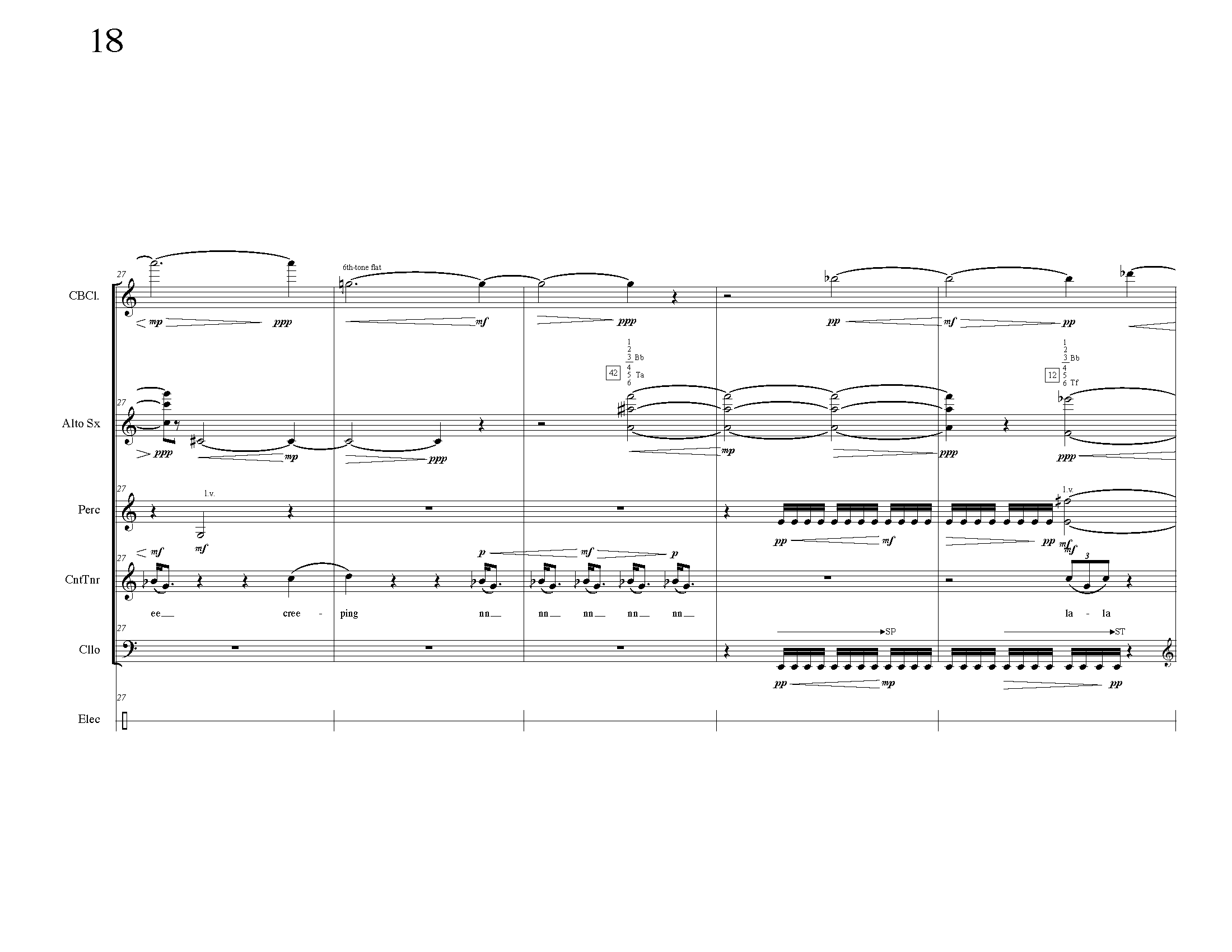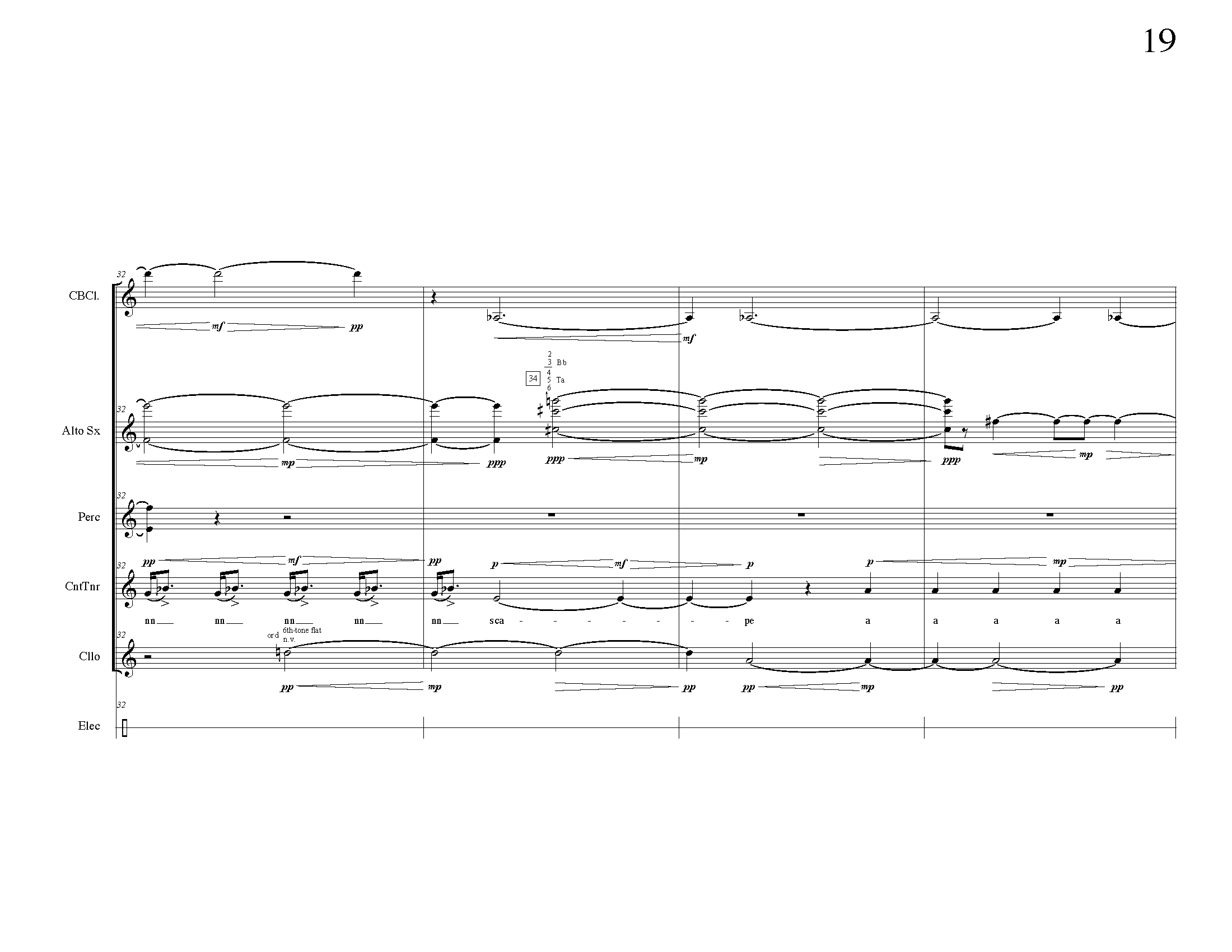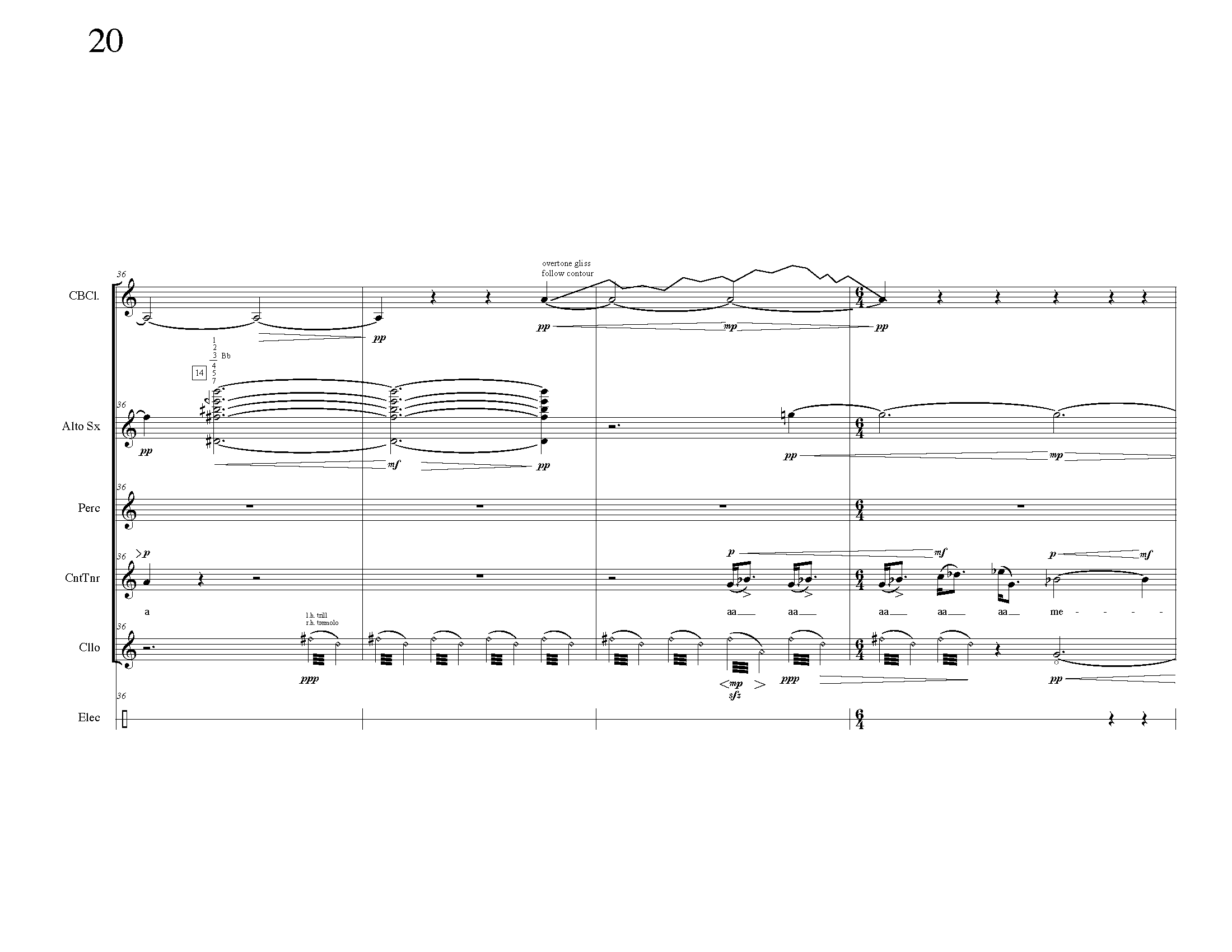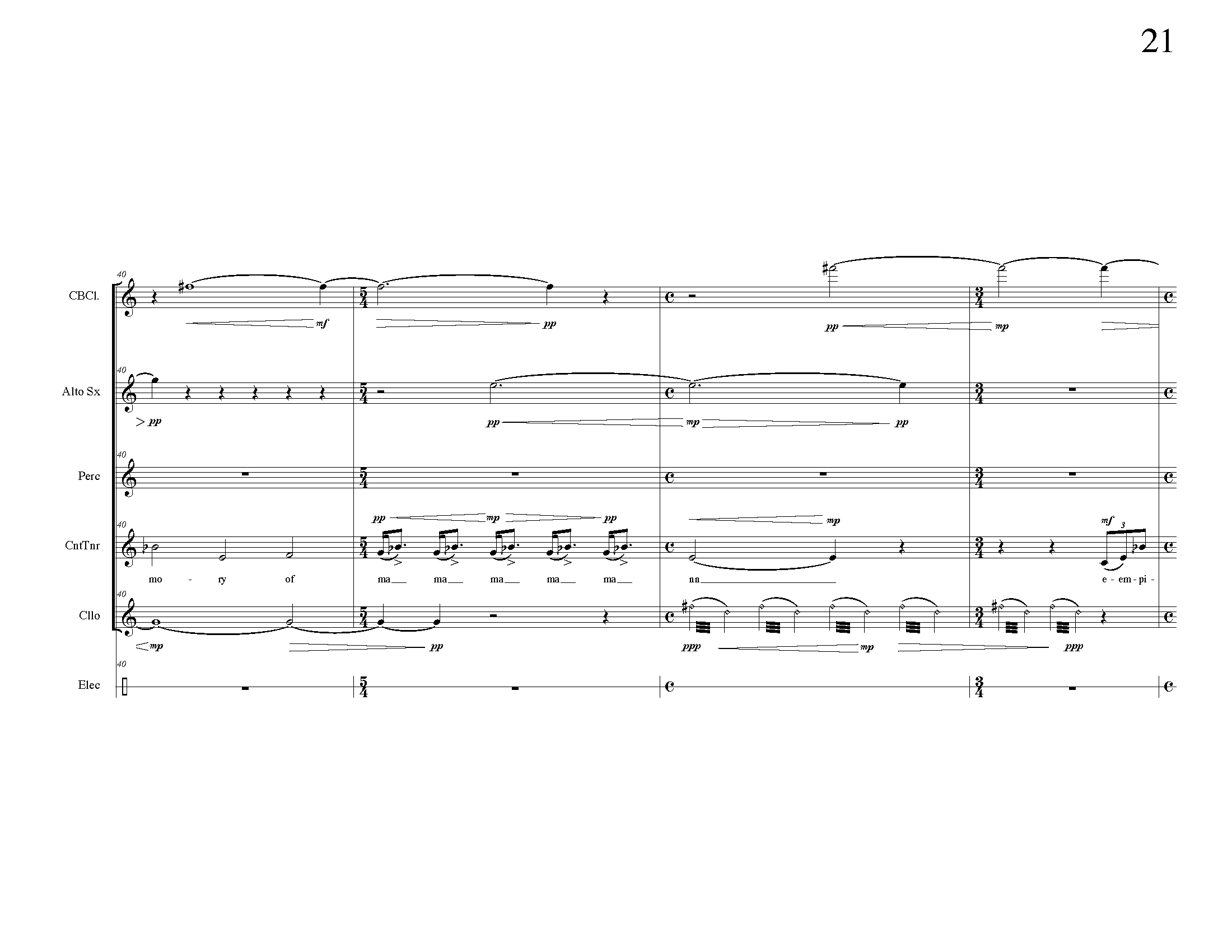Ken Ueno
Gallo
a fable in music in one act
(2014)| Duration | 90' |
|---|---|
| Movements | 12 scenes |
| Commission | Commissioned by Guerilla Opera |
| Premiere | May 22, 2014; The Zack Box Theater, Boston Conservatory, Boston, MA; Guerilla Opera |
| Roles | Galante/Farinelli, the Gallo, a 18th century aristocrat qua rooster – countertenor The Shopper/Mother – soprano |
| Instrumentation | clarinet (Bohlen Pierce, bass clarinet, contrabass clarinet), alto saxophone, percussion (bass drum (w/ pedal), 4 toms, snare, 2 brake drums, hi-hat, 2 sus. cymbals), cello, electronics |
| Technical requirements | Laptop and electronic playback |
| Publisher | PSNY |
| Staged performances of this work require licensing. |
Media
Program Note
Notes by Robert Kirzinger
On the morning of All Saints’ Day, 1755, the people of Lisbon, many of whom were attending Mass, felt the shock of a massive earthquake; fires broke out around the city, and thousands took to boats on the Tagus estuary to escape. Then the sea rose thrice and swallowed them, along with one of the great cities of Europe. The receding water left behind more fires, ultimately tens of thousands dead, and a city virtually leveled. On March 11, 2011, an earthquake with an epicenter less than 75 kilometers off the coast of Japan’s Tohoku region launched a tsunami that devastated cities for hundreds of miles and killed more than 15,000 people. In addition to displacement due to tsunami and earthquake damage, hundreds of thousands of residents near Fukushima were evacuated following three reactor core meltdowns at the Fukushima Daiichi Nuclear Power Station. Municipalities within twenty kilometers of the plant remain virtual ghost towns more than three years after the disaster.
In his opera Gallo (“Rooster”), Ken Ueno uses the Lisbon event as a resonator to clarify and examine the Tohoku event, emphasizing the amplification of catastrophe that technology—man’s attempt to extend his power (with that word’s many connotations)—brought to the more recent event. “Voltaire and Lisbon always are present always,” sings the countertenor in the prologue, referring to Candide’s fictional presence. This cross-referencing of disparate but ontologically (or kumatologically, as the composer might have it—kumatology is the study of waves) related events is a characteristic of Ueno’s approach not only in Gallo but in his work and life as a whole. The interplay of layers of activity and meaning, accumulations of potential via the interaction of different histories (both “objective” history and personal) are the very stuff of Ueno’s art. Gallo is by far the most explicit examination of these ideas to date.
Ontology, the metaphysical study of the state of being (the “thingness” of a thing; its identity as a thing) has as its useful folk-philosophy illustration the conundrum of the chicken and the egg. That koan-like paradox is also a part of Gallo, and one of the sources of its title. In Gallo’s Scene 2, “Landscape of Memory,” we learn: “The artificial hill called Monte Testaccio in Rome is made up of discarded amphorae dating back to the first century. It was ostensibly a rubbish dump, but it tells us about the whole structure of the economy of the Roman Empire.” The quotidian trash of a hundred centuries has become a treasure-trove for historians. This is one of a string of metaphors for Gallo itself, which is shot through with references and ideas from far-flung sources in cultural space and time.
It was inevitable that Ken Ueno would write an opera. Ideas for theater works have bubbled near, and sometimes broken, the surface of his work for several years now, many of them related in detailed and specific ways to his practice as a performer using extended vocal techniques. His vocal concerto On a Sufficient Condition for the Existence of Most Specific Hypothesis (2008) integrates a purely sonic narrative with one of personal identity, developing the character of “Ken Ueno” from childhood to adulthood. In his many “person specific” works, of which the vocal concerto is one and his recent Hapax Legomenon, Concerto for two-bow cello (composed for Frances-Marie Uitti and premiered this past January by the Boston Modern Orchestra Project) is another, the personalities, biographical events, and musical tendencies of his performers are wholly integrated into the content of the music. They are virtually theatrical narratives-in-waiting. Ueno’s engagement in other art forms, such as film, other visual arts, and architecture is another source of his work’s porousness and its ability to suggest, and to take on, multiple meanings.
In Gallo, Ueno brings his person-specific approach to bear in the specific and ongoing repertory situation of Guerrilla Opera, with its characteristic but flexible four-piece musical ensemble in which percussion, saxophone, and cello are (virtually) constants. In Gallo the fourth player is a clarinetist, Amy Advocat, who happens to be a specialist on the unusual Bohlen-Pierce clarinet. The instrument is custom-built for the Bohlen-Pierce scale, a non-standard scale based on equal- or just-tempered divisions of a perfect twelfth (and octave plus a fifth, unlike the octave-based scale we’re used to). Gallo includes a passage for this rare bird. A custom-built, custom-tuned metallophone, used prominently during the opera’s final lullaby, is another unique sonic source, as is the invented “language” of Chickenese. Chickenese exemplifies absurdist aspects of the opera (another is its cereal landscape) that relate the composer’s longstanding love for the work of Samuel Beckett. Ueno’s libretto draws on other artifacts gleaned from a hundred Mount Testaccios in the composer’s personal history, with varying degrees of observational objectivity. Much of its language is fragmentary, in a state of becoming or of deconstruction.
Gallo’s musical strata are both literal and metaphorical. The Scene 1 prologue, for example, uses as its main musical material the Baroque form of the passacaglia, a movement with a repeating harmonic pattern over which is played increasingly complex figures melodic. The repeating harmonic idea echoes the idea of ocean waves; the increasing complexity of the music it accompanies suggests the building intensity of the tsunami. Its division into interludes and episodes make it a true number opera come Verdi. Aria, traditional opera’s most identifiable and glorious trait, is a significant part of Gallo’s musical soul. And in spite of their far flung differences, each aria, each interlude informs and exemplifies the whole.
 0 items in your cart
0 items in your cart








